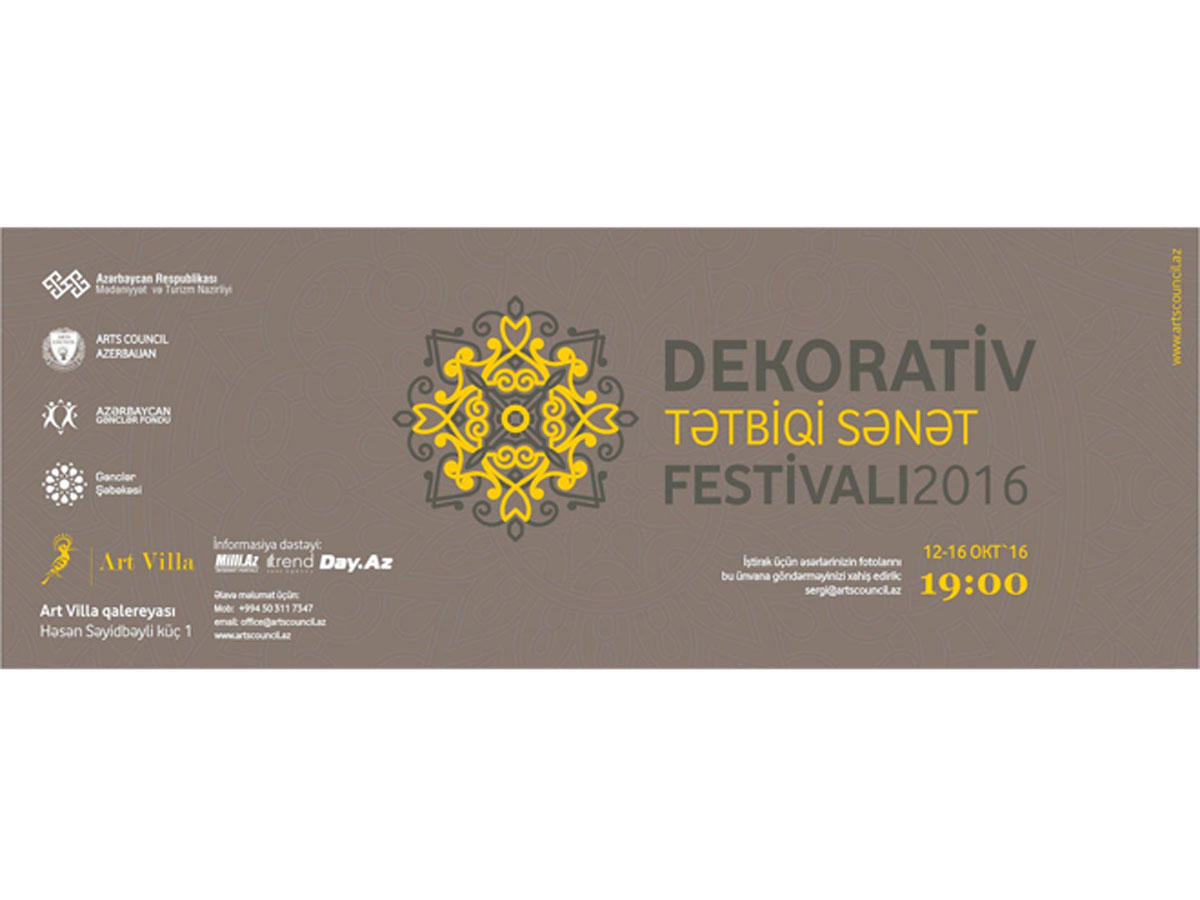Decorative and applied arts festival to kick off in Baku

By Laman Ismayilova
The glamorous festival of decorative and applied arts will kick off in Art Villa gallery on October 1.
The exhibition will feature original and unique pieces of art, including batik, tapestry, ceramics, stained glass, jewelry and rugs, Trend Life reported.
Being traditional, the festival aims at promotion and development of various types of decorative and applied art as well as to reveal new talents.
To participate in the festival, which will last October 16, it is necessary to e-mail the photos of works to [email protected]
The festival will be held with the financial support of the Azerbaijan Youth Foundation under the President of the Republic of Azerbaijan and NGO Arts Council Azerbaijan. Exhibition's curator is Sabina Najafova.
Each participant can send only five photos.
Entries with exact name and mobile phone number are accepted until October 1.
Media partners of the event are Trend, Day.az, and Milli.az.
For many centuries, Azerbaijani people have created a rich and distinctive culture, a major part of which is decorative and applied art.
The art form is represented by a wide range of handicrafts, including carpet weaving, batik (silk kerchief), gobelin, pottery (ceramics), knitting, embroidery, jewelry, art glass, art carving (wood, metal, stone, bone carving), etc.
One of the most widespread folk art is carpet weaving. There are biggest carpet making schools in Azerbaijan like Garabagh, Gazakh, Tabriz, Shirvan, Baku and Guba. Most of the Azerbaijani carpets are made of silk or wool of lamb and sheep.
Due to the high aesthetic value, they are used to decorate the walls and floors of marquees, huts, homes, nomads' tents, and other buildings. The unique patterns and overall rich colors provide great opportunities for the development of this industry.
Batik is an ancient type of art. Silk kerchief is square-shaped woven women's veils made of silk. In the western zone of Azerbaijan it is called as charqat. Azerbaijan produced silk kerchief is known from ancient times. The high quality kerchiefs were made in Tabriz, Ganja, Sheki, Nakhchivan cities, Basqal village of Ismayilli.
Since Middle Ages Ganja and Basqal silk kerchiefs were exported to foreign countries.
Known as Heyraty, Soqani, Istiotu, Albukharı, Abi, Yeleni, motley silk kerchiefs are appreciated as famous among many art lovers.
At present, there are many dynasties continued the work of weaving silk kerchief. The Samilovs are considered to be skilled master of this art in Sheki.
Another form of widespread decorative and applied arts is the gobelin. The art developed by the Arabs in the 12th century spread to many eastern countries, including Azerbaijan.
Gobelin is a "needle stitch painting", widespread in the world, and the culture of the ancient folk art.
The "art of eternity" is related to tapestry, but instead of being woven, it is sewn on canvas with a fine needle. Depending on size of the piece, its complexity of the design, the process may take from 3 months to 1 year.
Scale knitting is one of the most interesting artistic knitting. Small scales cut from metal (iron, bronze, silver, gold) are attached on silk curtains, mirror covers and makes various forms of plant and geometric forms and ornaments.
Scales are used widely in such Azerbaijani regions as Garabagh, Ganja, Nakhichevan, Baku and Sheki.
The art of carving is the act of using tools to shape something from by scraping away portions of that material. The technique can be applied to any material, including stone, wood, bone etc.
Stone carvings in Gobustan, Gamigaya are the best examples of the art of carving in Azerbaijan.
---
Laman Ismayilova is AzerNews’ staff journalist, follow her on Twitter: @Lam_Ismayilova
Follow us on Twitter @AzerNewsAz
